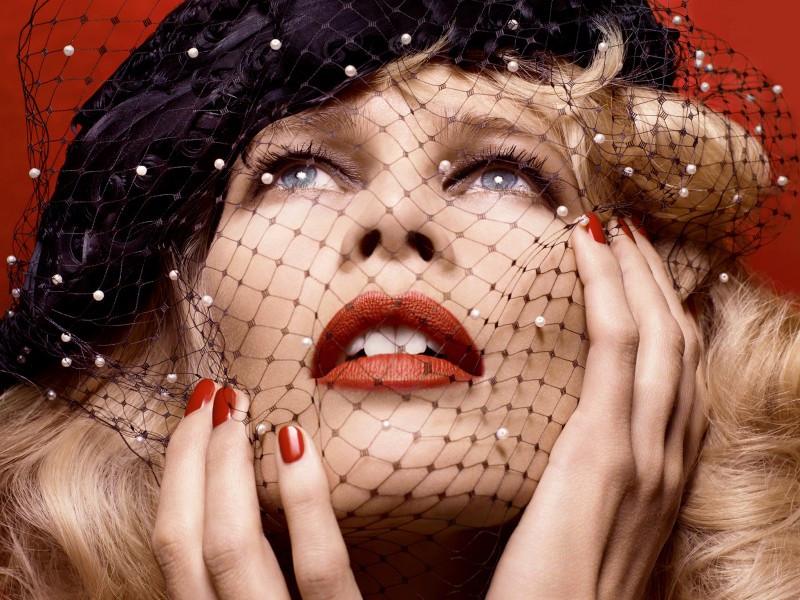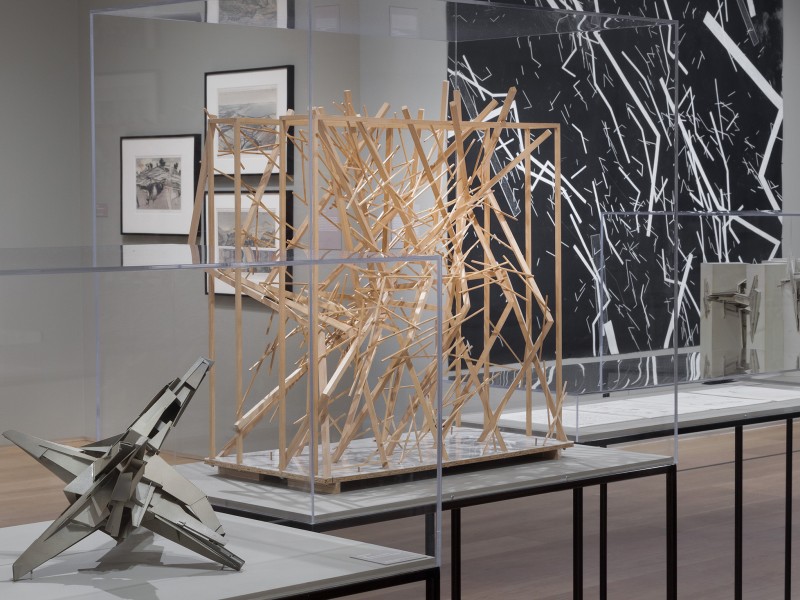Thirty metres below ground, carved out of chalk and limestone, is one of the biggest and most unusual private art galleries in Europe. Here, amid 18 kilometres of interconnected rib and barrel vault galleries, art is served at around 10 degrees—the same temperature as the 30 million bottles of champagne that surround it. This is the Domaine Pommery cellars, one of the most spectacular settings for art in the world.
Since the Vranken family bought Pommery in 2002 the cellars and grounds have been host to annual exhibitions of international avant-garde art. Each year some 135,000 visitors take the monumental staircase (116 stairs) to the cellars below to enter Pommery’s Expérience. The six month long exhibition features between thirty and forty artists whose work occupies the 110 arched limestone corridors and fills niches beneath chalk bas-reliefs created in the 19th century.
“This place offers a drama that most places with which we’re familiar cannot,” Bernard Blistène, guest curator of last year’s Expérience Pommery told Departures magazine. Blistène, director of cultural development at Paris’s Centre Pompidou, says: “I was struck not by the audacity, but by the freedom that Nathalie Vranken—wife of Pommery’s proprietor, Paul-François—gives the curators she invites.”
Artist Daniel Buren, and French art critics and curators like Regis Durand and Stephanie Moisdon are among the distinguished curators Madame Vranken has commissioned since 2003. This year curator Florence Derieux, together with multidisciplinary designer Matali Crasset who produced the exhibition design, celebrated 30 years of art in the district with Expérience 11. “I choose a curator who I know will pull in the right group of artists of the right calibre and we go from there,” Madame Vranken told Urban Life. “I don’t choose the artists, but of course I keep an eye on them. If one of them decided to paint everything yellow I will say, ‘thank you very much, but it’s not possible’. I am here to be the protector of what’s possible. I am the common sense.”
Judging by the art in the permanent collection and the exhibition themes, those possibilities are very open. Indeed, despite the historic surrounds and the trappings of tradition, the approach to art is far from stuffy. The same zesty flavour, ebullient spirit and joie de vivre one associates with champagne, animates the exhibitions and collections. Yes, that is an acrobatic elephant standing on its trunk, Daniel Firman’s sculpture Würsa. Meanwhile Laurent Grasso’s Truffaut-esque titled neon artwork day for night for day for night suggests either existential ennui or a never-ending party.
Amid ornate 19th century architecture, on 20 hectares of prime champagne producing land, one might glimpse a tree of plastic buckets (Pascale Marthine Tayou’s Talking Tree [2012]), or Stephen Wilks’ carousel of circling deflated animals, Donkey Roundabout (2000). Nearby Philippe Ramette’s whimsical levitating chair appears tethered to the ground, as if fearing it will float away, while Sylvie Fleury’s alien sculpture, Chitonia (2008), seems to have crash-landed.
These works are mementoes of past Expérience exhibitions, which, for the past decade have become Domaine Pommery’s signature event. Each year on opening day a chartered train from Paris Gare de l’Est takes visitors on the 45-minute ride to Reims, the heart of the Champagne district.
The exhibitions regularly play with the setting itself. While a spirit of whimsy floats above ground, down below many of the events playfully respond to the subterranean surrounds: Virginie Barre’s corpulent Batman, Fatbat (2005), leaps through his French ‘batcave’ while there’s a funhouse feel to Theo Mercier and Colin Johnco’s choir of spiral eyed skulls in Expérience 9. Inevitably such atmospheric galleries conjure allusions to an Aladdin’s cave, an evil genius’ lair, a superhero’s sanctum, the ethnographic curio, the archaeological dig and a general sense of adventure.
Many artists exploit the potential of light in the cellar depths. Jacqueline Dauriac’s Vertigo (2012) disorients viewers’ frame of reference using coloured lights down the tunnels. Richard Fauget’s Opalines lights hang throughout, while a laser beams down in Pierre-Laurent Cassiere’s work The Blue Ray (2011).
But just as many exhibits are drawn to the darkness: as we know darkness has a way of meticulously arousing all of the senses. Using such ordinary objects as metal plates and forklifts Expérience 9 (sound factory) played with unsettling industrial noises, conjured clanking Frankenstein experiments and generally nefarious goings-on.
Grand intellectual themes are also explored: Genesis (2004), or Marcel Duchamp’s continued influence in Idiocy (2005) and—this year—the Odyssey (2014). Judicaël Lavrador’s 2006 theme Supernova played on science-fiction imagery and took viewers on a space odyssey evoking space operas, satellites in orbit and mutant invaders.
There have been critical overviews as well. As part of the official program of France’s Presidency of the European Union, Fabrice Bousteau took a look at contemporary creation on the Continent, selecting works by some fifty young artists from every country in the European Union, a testament to its rich, vibrant art scene.
THE LONG TALL HISTORY
Corporations have long associated themselves with art, by collecting (Banks such as UBS and Deutsche), commissioning (BMW Art Cars) or sponsoring (you name it).
“We are not engaged in contemporary art simply because it’s fashionable,” Madame Vranken told Urban Life. “We have a great tradition in the field.”
The maison was founded in 1836. During the late nineteenth and the early twentieth century Madame Louise Pommery was a great supporter of art. Many of these important commissions are in the cellar itself. In 1882 Madame Pommery commissioned Gustave Navlet to sculpt monumental bas-reliefs from the cellar’s chalk walls and had busts made of her by sculptors Leon Joseph Chavaillaud and Henry Vasnier. Another relief was commissioned from art nouveau master Emile Gallé. He carved the ‘grand foudre’ or large barrel for the 1904 World Fair in St Louis, Missouri. Carved from Hungarian oak, the cask can hold the equivalent of 100,000 bottles of wine.
Meanwhile Madame Pommery’s earthenware collection—drawn from the prestigious centres of Rouen, Moustiers, Strasbourg, Nevers and Luneville, as well as porcelain from Sevres and pottery from Sinceny and Delft—was already famous during her lifetime. It now resides in the Reims Museum, as per her bequest. As for her love of painting, when Jean-Francois Millet’s Gleaners was up for auction and coveted by the United States, Madame Pommery bought it and also bequeathed it to the state (it now resides in the Musee D’Orsay). “What we want to do is to continue with [Madame Pommery’s] traditions, and to do that we have to have an interest in what’s new and combine that with what she built,” said Madame Vranken. Indeed following in Pommery’s footsteps Madame Vranken commissioned her own bas-relief in the chalk walls—Daniel Buren’s rather less ornate abstract stripes. “Louise Pommery was definitely tougher than I am,” Madame Vranken joked with Kunst magazine. “She made Navlet work in the chalk cellars for three years, but I only kept Daniel Buren working there for five days.”
Since acquiring the Pommery brand in 2002, the Vranken Pommery Monopole group has reignited the tradition of art patronage with the company. Where Madame Pommery pioneered the cellar tour, Madame Vranken combined it with an art experience. Around the world, partnerships with the Armory Show in New York, the Museum of Contemporary Art in Sydney, FIAC in Paris and Frieze in London have been established. Art is an essential pillar for developing the company, Madame Vranken has said.
Since starting his own company in 1976, Paul-François Vranken has built up an exceptional cellar of champagne houses. Before Pommery, he acquired Heidseick & Co. Monopole and Charles Lafitte. Together with a collection of exceptional vineyards totalling more than 2,500 hectares—in Champagne, France the Douro Valley of Portugal and the Mediterranean region—Vranken Pommery is the second biggest champagne producer in the world, and the number one producer of rosés.
Two of Domaine Pommery’s claims to fame in the art of champagne making are the invention of Brut champagne in 1874 and the marketing of quarter-litre bottles.
Related Features
-
39
-
-
-

